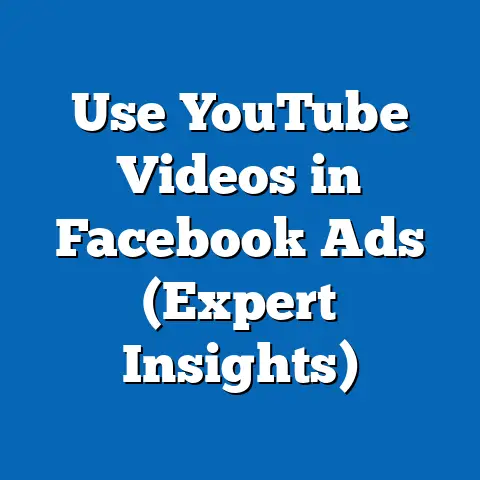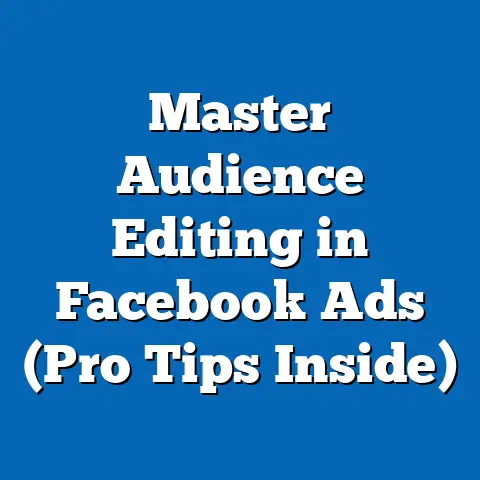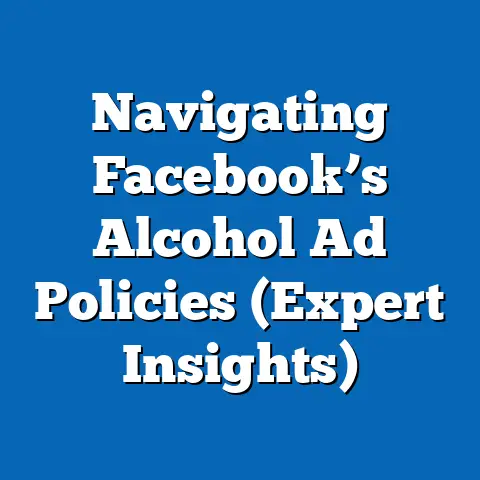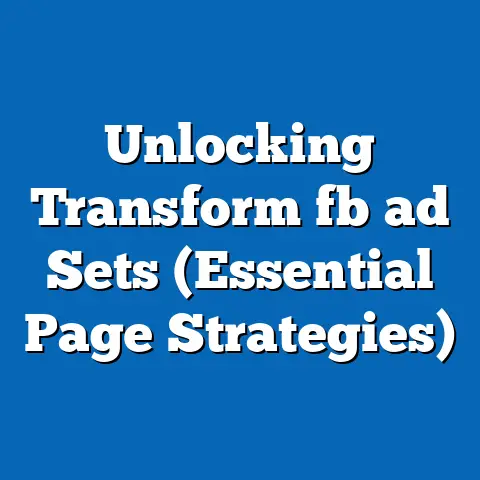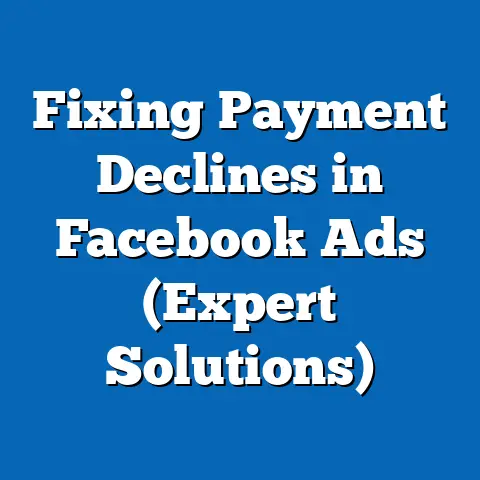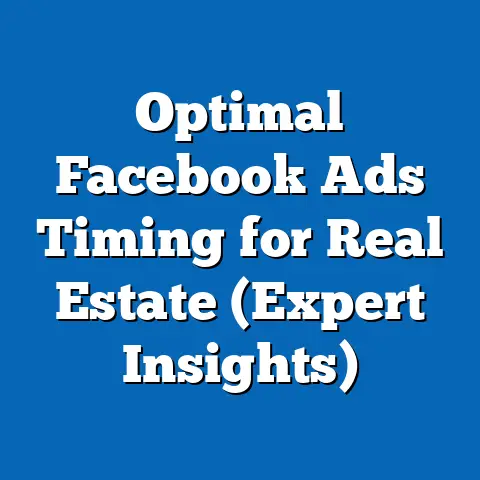Create Facebook Ads on Personal Accounts (Expert Guide)
The world of digital marketing is a constantly shifting landscape. What worked yesterday might be obsolete tomorrow. Platforms like Facebook are in a perpetual state of evolution, tweaking algorithms, introducing new ad formats, and updating their policies. To thrive in this environment, marketers and businesses need to be adaptable, informed, and ready to pivot.
While Facebook Ads are typically associated with business accounts and complex Ads Manager dashboards, there’s a powerful, often overlooked avenue for advertising: personal accounts. For individuals, small business owners on a tight budget, or those looking to connect with a specific niche audience, leveraging a personal Facebook account for advertising can be surprisingly effective.
I’ve seen firsthand how a well-crafted campaign launched from a personal account can generate significant buzz and even drive sales, especially when targeting local communities or specific interest groups. This guide is designed to equip you with the knowledge and strategies to successfully create Facebook Ads from your personal account, helping you navigate the platform’s complexities and maximize your reach.
Understanding Facebook Ads
Before diving into the specifics of using a personal account, let’s establish a solid understanding of what Facebook Ads are and why they’re so valuable.
What are Facebook Ads?
Facebook Ads are paid messages that businesses or individuals create to reach a specific audience on the Facebook platform. These ads can appear in various places, including the news feed, right column, Marketplace, and even within Facebook’s partner network.
Unlike organic posts, which are only visible to your existing followers and friends, Facebook Ads allow you to target a much wider audience based on factors like:
- Demographics: Age, gender, location, education, and more.
- Interests: Hobbies, passions, and things people are interested in.
- Behaviors: Online activities, purchase history, and device usage.
- Connections: People who like your page, their friends, or custom audiences you upload.
Why Use Facebook Ads?
The benefits of using Facebook Ads are numerous and compelling:
- Targeted Reach: As mentioned above, the ability to pinpoint your ideal customer is a game-changer. No more wasting money on ads that reach the wrong people.
- Engagement Potential: Facebook is a social platform, and ads can be designed to encourage interaction. Likes, comments, shares, and even direct messages can help build relationships with potential customers.
- Cost-Effectiveness: Compared to traditional advertising methods like print or television, Facebook Ads can be incredibly cost-effective. You have complete control over your budget and can adjust it as needed.
- Measurable Results: Facebook provides detailed analytics that allow you to track the performance of your ads. You can see exactly how many people saw your ad, how many clicked on it, and how many converted into customers.
Why Use a Personal Account for Advertising?
Now, let’s address the elephant in the room: Why even consider using a personal account for advertising when Facebook offers dedicated business accounts?
- Authenticity and Trust: Ads from personal accounts can sometimes feel more authentic and relatable, especially when targeting friends, family, or local communities. People are often more receptive to messages from individuals they know or perceive as “one of them.”
- Simplicity and Speed: For those who are new to Facebook advertising, using a personal account can be a simpler and faster way to get started. The Ads Manager interface can be overwhelming, and boosting a post directly from your personal feed can feel more intuitive.
- Budget Constraints: For individuals or small businesses with limited budgets, the cost of setting up and maintaining a full-fledged business account (including website development, branding, etc.) can be prohibitive. A personal account allows you to dip your toes into the advertising waters without a significant upfront investment.
- Targeting Existing Network: If your goal is to reach your existing network of friends and family, or a specific group of people you’re connected to on Facebook, using a personal account can be the most direct and effective approach.
I remember when I was first starting out, I used my personal account to promote a small craft fair I was organizing. I targeted my local community and friends who I knew were interested in handmade goods. The response was incredible! I generated a ton of buzz and had a packed house at the fair. It was a great way to get my feet wet with Facebook advertising without feeling overwhelmed by all the bells and whistles of Ads Manager.
Takeaway: Facebook Ads offer incredible potential for reaching a targeted audience. While business accounts are the standard for most businesses, personal accounts can be a valuable tool for individuals and small businesses looking for a simpler, more authentic approach.
Setting Up Your Personal Account for Advertising
Before you start creating ads, it’s important to ensure your personal account is properly set up and optimized for advertising purposes.
Creating a Facebook Account (If Necessary)
If you don’t already have a Facebook account, the first step is to create one. The process is straightforward:
- Go to Facebook’s homepage and click “Create New Account.”
- Enter your name, email address or phone number, password, date of birth, and gender.
- Click “Sign Up.”
- Follow the instructions to confirm your email address or phone number.
Once your account is created, it’s important to optimize your profile for business purposes:
- Profile Picture: Use a professional-looking headshot or a logo that represents your brand.
- Cover Photo: Choose a visually appealing image that showcases your product, service, or brand personality.
- About Section: Write a compelling bio that highlights your expertise and what you offer. Include a call to action, such as “Visit my website” or “Contact me for a free consultation.”
- Privacy Settings: Review your privacy settings to ensure that your profile is visible to the public or at least to the target audience you’re trying to reach.
- Professional Mode: Facebook now offers a professional mode for profiles that allows you to access business tools and insights. Consider switching to professional mode for added functionality.
Understanding Facebook’s Advertising Policies
Before you start creating ads, it’s crucial to familiarize yourself with Facebook’s advertising policies. These policies outline what types of content are allowed and prohibited on the platform. Violating these policies can result in your ads being rejected, your account being suspended, or even permanently banned.
Some key advertising policies to be aware of include:
- Prohibited Content: Ads that promote illegal activities, discrimination, violence, or hate speech are strictly prohibited.
- Misleading or Deceptive Content: Ads that make false claims, exaggerate product benefits, or mislead users are not allowed.
- Personal Attributes: Ads that directly reference or imply personal attributes like race, ethnicity, religion, sexual orientation, or health conditions are prohibited.
- Sensitive Topics: Ads that exploit sensitive topics like tragedies, natural disasters, or political issues are not allowed.
- Grammar and Punctuation: Ads must be written in clear and correct grammar and punctuation.
I once had an ad rejected because I used the phrase “get rid of your wrinkles.” Facebook considered this to be a health-related claim that required substantiation. I had to reword the ad to focus on the product’s ability to “reduce the appearance of fine lines and wrinkles” to comply with their policy.
Engaging Your Network
One of the biggest advantages of using a personal account for advertising is the ability to leverage your existing network of friends, family, and connections. Building an engaged network can significantly amplify the reach and impact of your ads.
Here are some tips for engaging your network:
- Post Regularly: Share valuable content that is relevant to your target audience. This could include articles, blog posts, videos, or even just interesting thoughts and ideas.
- Engage with Others: Like, comment, and share content from other people in your network. This helps to build relationships and increase your visibility.
- Join Relevant Groups: Find and join Facebook groups that are related to your industry or niche. Participate in discussions, share your expertise, and connect with potential customers.
- Create Your Own Group: Consider creating your own Facebook group to build a community around your brand or product. This gives you a direct line of communication with your target audience.
- Ask Questions: Encourage engagement by asking questions in your posts. This helps to start conversations and get people talking about your brand.
Takeaway: Setting up your personal account properly and engaging with your network are crucial steps in maximizing the effectiveness of your Facebook advertising efforts. Make sure to familiarize yourself with Facebook’s advertising policies to avoid any potential issues.
Crafting Your Facebook Ad Content
The content of your Facebook Ads is arguably the most important factor in determining their success. Compelling ad copy and visually appealing images or videos are essential for capturing attention, generating interest, and driving conversions.
Identifying Your Audience
Before you start writing ad copy or creating visuals, it’s important to clearly define your target audience. Who are you trying to reach with your ads? What are their demographics, interests, and behaviors?
If you’re using a personal account, you can leverage insights from your existing network to identify your target audience. Look at the demographics, interests, and behaviors of your friends and connections. Are there any common themes or patterns?
You can also use Facebook’s Audience Insights tool to get a better understanding of your target audience. This tool allows you to analyze the demographics, interests, and behaviors of people who like your page or who are connected to your friends.
Creating Compelling Ad Copy
Your ad copy is your opportunity to persuade people to take action. It should be clear, concise, and compelling. Here are some tips for writing effective ad copy:
- Headline: Your headline is the first thing people will see, so it needs to grab their attention. Use strong verbs, intriguing questions, or compelling offers.
- Body Text: Your body text should provide more information about your product or service and explain the benefits of using it. Focus on solving a problem or fulfilling a need.
- Call to Action: Your call to action tells people what you want them to do next. Use clear and direct language, such as “Learn More,” “Shop Now,” or “Contact Us.”
- Keep it Short and Sweet: People have short attention spans, so keep your ad copy concise and to the point. Get rid of any unnecessary words or phrases.
- Use Emotion: Connect with your audience on an emotional level by using language that evokes feelings of excitement, happiness, or urgency.
I’ve found that using a storytelling approach can be particularly effective in ad copy. Sharing a personal anecdote or a customer success story can help to build trust and credibility.
Visual Elements of Your Ads
The visual elements of your ads are just as important as the ad copy. High-quality images or videos can capture attention, convey your message, and drive engagement.
Here are some tips for creating effective visuals:
- Use High-Quality Images: Avoid using blurry or pixelated images. Use high-resolution images that are clear and visually appealing.
- Choose Relevant Images: Select images that are relevant to your product or service and that resonate with your target audience.
- Use Videos: Videos are a great way to capture attention and convey your message. Keep your videos short and engaging.
- Use Bright Colors: Bright colors can help your ads stand out from the crowd.
- Test Different Visuals: Experiment with different images and videos to see what works best for your target audience.
Takeaway: Crafting compelling ad copy and using visually appealing images or videos are essential for creating effective Facebook Ads. Make sure to clearly define your target audience and tailor your content to their interests and needs.
Utilizing Facebook’s Ad Features
Facebook offers a variety of ad features that can help you to target your audience, set your budget, and track your performance. Understanding these features is crucial for maximizing the effectiveness of your advertising efforts.
Ads Manager vs. Boosting Posts
As I mentioned earlier, there are two main ways to create Facebook Ads from a personal account: using Facebook Ads Manager or boosting posts directly from your feed.
- Facebook Ads Manager: Ads Manager is a more advanced tool that allows you to create highly targeted ads with a wide range of customization options. It’s ideal for businesses that want to run sophisticated advertising campaigns.
- Boosting Posts: Boosting a post is a simpler and faster way to get your content in front of a wider audience. It’s ideal for individuals or small businesses that want to quickly promote a post and reach a specific target audience.
The benefits of using Ads Manager include:
- Advanced Targeting: Target your audience based on demographics, interests, behaviors, and connections.
- Multiple Ad Formats: Choose from a variety of ad formats, including image ads, video ads, carousel ads, and more.
- Detailed Analytics: Track the performance of your ads with detailed analytics and reporting.
The benefits of boosting posts include:
- Simplicity: It’s a simple and intuitive way to get your content in front of a wider audience.
- Speed: You can boost a post in just a few clicks.
- Cost-Effectiveness: It can be a cost-effective way to reach a specific target audience.
Setting Your Budget
Setting a budget for your ads is crucial for controlling your spending and maximizing your return on investment. Facebook allows you to set either a daily budget or a lifetime budget.
- Daily Budget: Your daily budget is the average amount you’re willing to spend each day. Facebook will try to spend this amount each day, but it may sometimes spend slightly more or less.
- Lifetime Budget: Your lifetime budget is the total amount you’re willing to spend on your ad campaign. Facebook will try to spread this amount evenly over the duration of your campaign.
It’s important to choose a bidding strategy that aligns with your advertising goals. Facebook offers several bidding strategies, including:
- Automatic Bidding: Facebook automatically sets your bids to get the most results for your budget.
- Manual Bidding: You manually set your bids for each ad. This gives you more control over your spending, but it also requires more expertise.
Choosing Ad Formats
Facebook offers a variety of ad formats to choose from, including:
- Image Ads: Simple ads that feature a single image and ad copy.
- Video Ads: Ads that feature a video and ad copy.
- Carousel Ads: Ads that feature multiple images or videos in a carousel format.
- Collection Ads: Ads that showcase a collection of products in a visually appealing format.
- Lead Ads: Ads that allow people to sign up for your email list or request more information.
The best ad format for you will depend on your advertising goals and your target audience. Experiment with different formats to see what works best.
Takeaway: Facebook offers a variety of ad features that can help you to target your audience, set your budget, and track your performance. Understanding these features is crucial for maximizing the effectiveness of your advertising efforts.
Launching Your Facebook Ad Campaign
Now that you’ve crafted your ad content and selected your ad features, it’s time to launch your Facebook Ad campaign.
Step-by-Step Guide to Launching an Ad
Here’s a step-by-step guide to launching an ad from your personal account using Ads Manager:
- Go to Facebook Ads Manager.
- Click “Create.”
- Choose your advertising objective.
- Define your target audience.
- Set your budget and schedule.
- Choose your ad format.
- Create your ad content.
- Review your ad and click “Publish.”
Tracking and Analyzing Performance
Once your ad is launched, it’s important to track its performance and analyze the results. Facebook provides detailed analytics that allow you to see how many people saw your ad, how many clicked on it, and how many converted into customers.
Key metrics to track include:
- Reach: The number of people who saw your ad.
- Impressions: The number of times your ad was displayed.
- Click-Through Rate (CTR): The percentage of people who clicked on your ad after seeing it.
- Cost Per Click (CPC): The average cost you paid for each click on your ad.
- Conversion Rate: The percentage of people who completed a desired action (e.g., purchased a product, signed up for your email list) after clicking on your ad.
- Return on Ad Spend (ROAS): The amount of revenue you generated for every dollar you spent on advertising.
By tracking these metrics, you can identify what’s working and what’s not, and make adjustments to your campaign accordingly.
Takeaway: Launching your Facebook Ad campaign is just the beginning. Tracking and analyzing your performance is crucial for optimizing your campaign and maximizing your results.
Troubleshooting Common Issues
Even with the best planning and execution, you may encounter issues when running Facebook Ads from a personal account. Here are some common problems and how to troubleshoot them.
Ad Rejections and How to Handle Them
As mentioned earlier, Facebook has strict advertising policies, and your ads may be rejected if they violate these policies. If your ad is rejected, Facebook will provide a reason for the rejection.
To handle ad rejections:
- Review the Reason: Carefully review the reason for the rejection and identify the policy that your ad violated.
- Edit Your Ad: Edit your ad to comply with the policy. This may involve changing the ad copy, the image, or the targeting.
- Appeal the Decision: If you believe that your ad was rejected in error, you can appeal the decision.
Adjusting Campaigns Based on Performance
Your ad campaign may not perform as expected. If your ads are not generating the desired results, you may need to make adjustments to your campaign.
Strategies for adjusting ad campaigns based on performance data include:
- Refine Your Targeting: Make sure you’re targeting the right audience. Experiment with different demographics, interests, and behaviors.
- Improve Your Ad Copy: Make sure your ad copy is clear, concise, and compelling. Use strong verbs, intriguing questions, or compelling offers.
- Change Your Visuals: Experiment with different images and videos to see what works best for your target audience.
- Adjust Your Bidding Strategy: Experiment with different bidding strategies to see what generates the best results for your budget.
- Pause Underperforming Ads: If some of your ads are not performing well, pause them and focus on the ads that are generating the best results.
Takeaway: Be prepared to troubleshoot common issues and make adjustments to your campaign based on performance data. Adaptability is key to success in Facebook advertising.
The Future of Advertising on Personal Accounts
The landscape of Facebook advertising is constantly evolving, and the role of personal accounts in this landscape is likely to continue to change. As Facebook continues to refine its algorithms and introduce new features, it’s important to stay informed and adapt your strategies accordingly.
While using personal accounts for advertising may come with unique challenges, the potential for meaningful connections and targeted reach remains significant. As long as you prioritize authenticity, compliance with Facebook’s policies, and a commitment to providing value to your audience, you can continue to leverage your personal account to achieve your advertising goals.
I encourage you to start implementing the strategies discussed in this guide and to continuously learn and adapt as you grow your advertising skills on Facebook. The world of digital marketing is full of opportunities, and with the right knowledge and approach, you can achieve success, even when starting from a personal account.
So, go ahead, experiment, learn, and grow. Your Facebook advertising journey is just beginning!

